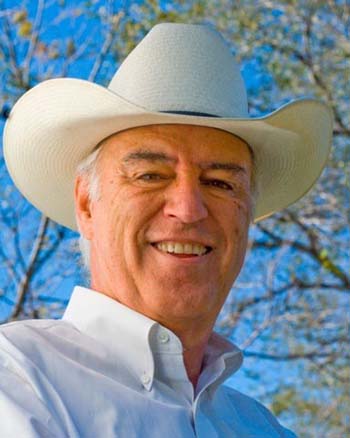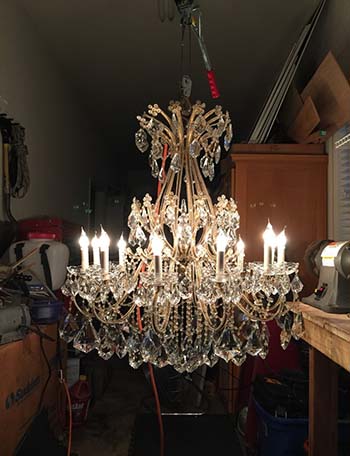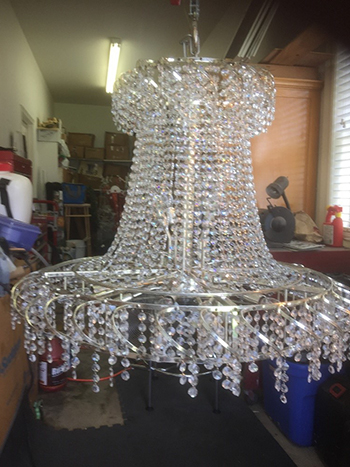
Jim Ross Lightfoot (NAFB Emeritus Member, White Oak, TX) asks and answers his own question, “What do old farm broadcasters do when they’ve read their last market report and filed their last story? Reminisce! Yes, we oldtimers do a lot of that.” Jim says he was very fortunate to have started his career in farm broadcasting with an excellent broadcaster by the name of Jack Gowing. “Jack was a great mentor, and he taught me many things that I still use today.  In those days the major livestock yards were operating in places like Omaha and Chicago. Between the American Royal Stock Show in Kansas City, Denver Stock Show, Chicago Stock Show and others, we had plenty to do. Of course, covering these events was in addition to our regular broadcasting where we did our best to provide producers information of interest and relevance to their operation.” From 1970 until 1976, Jim took a hiatus from KMA (Shenandoah, IA) to manage a manufacturing operation for the old Farmaster Gate Company. They were opening a new operation in the community of Corsicana, TX. It was Jim’s job to open the factory from scratch and then continue to expand its sales. “Things were going very, very well until the parent company was sold to the Wickes Corporation out of California. They were losing so much money in the modular home business that they started picking all the profits out of the Farmaster plants they had acquired. By 1976 it was all over.” Jim and his family returned to Iowa. “Fortunately, I was able to return to KMA radio and its first class farm department. Creighton Knau was the farm director. Creighton was one-of-a-kind, and we hit it off from the start. We were covering events all over the country.” In 1983, President Ronald Reagan had proposed a trip to the Philippines and South Korea to enhance trade with the United
In those days the major livestock yards were operating in places like Omaha and Chicago. Between the American Royal Stock Show in Kansas City, Denver Stock Show, Chicago Stock Show and others, we had plenty to do. Of course, covering these events was in addition to our regular broadcasting where we did our best to provide producers information of interest and relevance to their operation.” From 1970 until 1976, Jim took a hiatus from KMA (Shenandoah, IA) to manage a manufacturing operation for the old Farmaster Gate Company. They were opening a new operation in the community of Corsicana, TX. It was Jim’s job to open the factory from scratch and then continue to expand its sales. “Things were going very, very well until the parent company was sold to the Wickes Corporation out of California. They were losing so much money in the modular home business that they started picking all the profits out of the Farmaster plants they had acquired. By 1976 it was all over.” Jim and his family returned to Iowa. “Fortunately, I was able to return to KMA radio and its first class farm department. Creighton Knau was the farm director. Creighton was one-of-a-kind, and we hit it off from the start. We were covering events all over the country.” In 1983, President Ronald Reagan had proposed a trip to the Philippines and South Korea to enhance trade with the United  States. One Sunday afternoon, we were sitting at home when the telephone rang. “My wife, Nancy, answered. After a few moments, she came into the living room where I was sitting and said, “The phone call is for you.” “Who is it? I asked. It’s the White House,” she said. “I did not believe her. However, after much coaxing, she convinced me that it was the White House. On the phone was Billy Dale, who was in charge of all transportation for the White House. He extended an invitation for me to accompany the President on his trip to Southeast Asia. Billy explained that everyone that made the trip would share alike in the cost. His estimate was that my share would be $6,000. “I told him I would have to get approval from my management. He gave me a private phone number to call him back with an answer either yes or no. Fortunately, I was able to sell the idea to our station management.” As Jim and his wife discussed the upcoming trip, it was unclear to him why he had been invited. “It turns out my wife, Nancy, wrote a letter to President Reagan’s wife Nancy explaining to her that since this was going to be an agricultural trade trip Sam Donaldson didn’t know an ear of corn from a soybean. My Nancy suggested it might make sense to put someone on the trip that knew about agriculture. Apparently, Nancy Reagan read her mail, and she put into motion the process to issue me an invitation. Wow, this was pretty heady stuff for an old farm boy from southwest Iowa!” One of the highlights for Jim was when he was picked to be one of the pool reporters that went to the DMZ. “We were there on a Sunday morning. You could see the North Koreans across the cleared fields between the two countries. Heavy army equipment sat with engines idling and drivers at the wheel. 50 caliber machine guns were locked and loaded. To say the air was tense would be a huge understatement. President Reagan arrived and joined our group standing in the middle of the heavy weapons carriers. The Chaplin spoke first.” Jim recalls his words as if it were just yesterday. “Gentlemen, this morning we stand on the edge of freedom.” He then continued his sermon and talked about the good news from Jesus. “To say it was moving would be a gross understatement,” Jim said. “I told this story on the air when we got home. At the time, we had many preachers, pastors and priests who were devoting their sermons to political diatribe regarding the situation in Central America. A sidebar suggestion was made that perhaps we would all be better served if the sermons in America were similar to one that had been preached at the DMZ.” Jim exclaimed, “Whoopee, talk about a way to stir up hate mail from a bunch of angry preachers! At least, I knew they were listening.” On September 27, Jim observed that he’s seen this old Globe circle the sun 80 times. “God has given me very much. As someone who was born in the Florence Crittenden Home for Unwed Mothers in Sioux City, IA, adopted by a wonderful farm family from southwestern Iowa, served in the U.S. Army, served 12 years as a U.S. Congressman, spent 13 years making the world a safer place through a company named Forensic Technology and some 19 years in commercial broadcasting. Life has been good.” He added, “I’ve reached that age where I don’t even buy green bananas. I don’t get around as good as I once did, and I shake my head at the changes I have seen in our world. I mark my experiences as a farm broadcaster at the top of the list of good things that have happened. Today, time is spent reading a good book, writing an occasional op-ed, fixing up an old chandelier for my wife to sell in her antique business or just sitting and scratching the dog. And that my friends, is pretty much what an old farm broadcaster does.”
States. One Sunday afternoon, we were sitting at home when the telephone rang. “My wife, Nancy, answered. After a few moments, she came into the living room where I was sitting and said, “The phone call is for you.” “Who is it? I asked. It’s the White House,” she said. “I did not believe her. However, after much coaxing, she convinced me that it was the White House. On the phone was Billy Dale, who was in charge of all transportation for the White House. He extended an invitation for me to accompany the President on his trip to Southeast Asia. Billy explained that everyone that made the trip would share alike in the cost. His estimate was that my share would be $6,000. “I told him I would have to get approval from my management. He gave me a private phone number to call him back with an answer either yes or no. Fortunately, I was able to sell the idea to our station management.” As Jim and his wife discussed the upcoming trip, it was unclear to him why he had been invited. “It turns out my wife, Nancy, wrote a letter to President Reagan’s wife Nancy explaining to her that since this was going to be an agricultural trade trip Sam Donaldson didn’t know an ear of corn from a soybean. My Nancy suggested it might make sense to put someone on the trip that knew about agriculture. Apparently, Nancy Reagan read her mail, and she put into motion the process to issue me an invitation. Wow, this was pretty heady stuff for an old farm boy from southwest Iowa!” One of the highlights for Jim was when he was picked to be one of the pool reporters that went to the DMZ. “We were there on a Sunday morning. You could see the North Koreans across the cleared fields between the two countries. Heavy army equipment sat with engines idling and drivers at the wheel. 50 caliber machine guns were locked and loaded. To say the air was tense would be a huge understatement. President Reagan arrived and joined our group standing in the middle of the heavy weapons carriers. The Chaplin spoke first.” Jim recalls his words as if it were just yesterday. “Gentlemen, this morning we stand on the edge of freedom.” He then continued his sermon and talked about the good news from Jesus. “To say it was moving would be a gross understatement,” Jim said. “I told this story on the air when we got home. At the time, we had many preachers, pastors and priests who were devoting their sermons to political diatribe regarding the situation in Central America. A sidebar suggestion was made that perhaps we would all be better served if the sermons in America were similar to one that had been preached at the DMZ.” Jim exclaimed, “Whoopee, talk about a way to stir up hate mail from a bunch of angry preachers! At least, I knew they were listening.” On September 27, Jim observed that he’s seen this old Globe circle the sun 80 times. “God has given me very much. As someone who was born in the Florence Crittenden Home for Unwed Mothers in Sioux City, IA, adopted by a wonderful farm family from southwestern Iowa, served in the U.S. Army, served 12 years as a U.S. Congressman, spent 13 years making the world a safer place through a company named Forensic Technology and some 19 years in commercial broadcasting. Life has been good.” He added, “I’ve reached that age where I don’t even buy green bananas. I don’t get around as good as I once did, and I shake my head at the changes I have seen in our world. I mark my experiences as a farm broadcaster at the top of the list of good things that have happened. Today, time is spent reading a good book, writing an occasional op-ed, fixing up an old chandelier for my wife to sell in her antique business or just sitting and scratching the dog. And that my friends, is pretty much what an old farm broadcaster does.”
 Jim’s wife Nancy deals in antique elegant glassware and crystal.
Jim’s wife Nancy deals in antique elegant glassware and crystal. “I’m not elegant but, I do qualify as antique.” In attending various sales, it became apparent that some of these old houses had some very beautiful chandeliers. So, a unique hobby evolved. “We have to take the chandeliers down and then they go to my shop. The first thing I do is check the wiring as these fixtures are very old and many of them have unsafe wiring. Once the wiring is made safe the cleaning process starts. For the most part, these fixtures have hung for many years without anyone paying attention to them. To say they are dirty is an understatement.” In many cases it means removing all the crystals from the fixture and washing them separately. It’s not uncommon to have more than 300 crystals on one fixture. “Each one is painstakingly cleaned by hand and then reassembled. At times, I have to find replacement crystals for those that have been lost or broken. Although it is time- consuming work, there is much pleasure in seeing an old antique chandelier come back to life.”
“I’m not elegant but, I do qualify as antique.” In attending various sales, it became apparent that some of these old houses had some very beautiful chandeliers. So, a unique hobby evolved. “We have to take the chandeliers down and then they go to my shop. The first thing I do is check the wiring as these fixtures are very old and many of them have unsafe wiring. Once the wiring is made safe the cleaning process starts. For the most part, these fixtures have hung for many years without anyone paying attention to them. To say they are dirty is an understatement.” In many cases it means removing all the crystals from the fixture and washing them separately. It’s not uncommon to have more than 300 crystals on one fixture. “Each one is painstakingly cleaned by hand and then reassembled. At times, I have to find replacement crystals for those that have been lost or broken. Although it is time- consuming work, there is much pleasure in seeing an old antique chandelier come back to life.”
